Research on the Application of Fracture Water to Mitigate the Thermal Imbalance of a Rock Mass Associated with the Operation of Ground-Coupled Heat Pumps
Abstract
:1. Introduction
2. Laboratorial Experiment
2.1. Sampling and Materials
2.2. Experiment System
2.3. Model Specifications
2.4. Experimental Results and Discussion
3. Numerical Simulation
3.1. Geometry of the Model
3.2. Control Equations
3.3. Boundary and Initial Conditions
3.4. Meshing
3.5. Numerical Results and Discussion
4. Conclusions
- (1)
- For U pipes buried in karst areas with dense and low-permeability carbonate rock masses, the heat transfer between the U pipes and the rock mainly depends on heat conduction instead of convection. Therefore, the energy in the rock mass is difficult to dissipate to the surrounding formations in time, and it is possible that a thermal imbalance in the underground heat exchange area will occur. However, a rock mass with abundant fracture groundwater offers opportunities to mitigate the thermal imbalance with convection brought by water flow. The contribution of fracture water to the thermal balance of the rock mass is obvious because the energy carried by the flow of water is tremendous. In the simulated cooling period in the experiment, the rock body with one horizontal fracture was heated, and the center temperature of the rock mass was affected by the existence of fracture water. The differences in temperature at different depths were 7.5 K, 7.5 K, and 2 K, respectively, compared with the non-fracture rock mass. However, the effect of the fracture water was constrained in areas close to the fracture.
- (2)
- In the simulated heating period in winter, regardless of whether the rock mass had one fracture or two fractures, the temperature of the surrounding rock mass around the fracture was higher than that of the area without the fracture. The gradient of temperature curve of the rock mass nearby the fracture water was flattened due to the existence of the flowing fracture water. It is obvious that when the number of fractures increased, the effect was enhanced.
- (3)
- The rock mass with the fracture had a small temperature variation during the operation, and the temperature also recovered more quickly during the shutdown period. This is because the fracture water flow volume was proportional to the cubic of the fracture width, so the supplementary energy it carried was significant and effectively enhanced the thermal recovery ability of the rock mass.
- (4)
- Artificial fractures might be used to enhance water flow and heat transfer, but such an approach might be constrained or forbidden in project sites or urban areas. Therefore, it is proposed that the U pipes should be located at zones with abundant fracture water if the construction condition permits. U pipes that are near the fractures should share more of the load or a denser layout could be possible as their heat transfer capacity is improved by the water flow.
Author Contributions
Funding
Institutional Review Board Statement
Informed Consent Statement
Data Availability Statement
Conflicts of Interest
References
- Luo, T.; Pei, P.; Chen, Y.; Hao, D.; Wang, C. Improvements in the Water Retention Characteristics and Thermophysical Parameters of Backfill Material in Ground Source Heat Pumps by a Molecular Sieve. Energies 2022, 15, 1801. [Google Scholar] [CrossRef]
- Zou, H.; Pei, P.; Zhang, J. Impacts of hydrogeological characters of fractured rock on thermodynamic performance of ground-coupled heat pump. PLoS ONE 2021, 16, e0252056. [Google Scholar] [CrossRef] [PubMed]
- Luo, J.; Wang, H.; Zhang, H.; Yan, Z. A geospatial assessment of the installation potential of shallow geothermal systems in a graben basin. Renew. Energy 2021, 165, 553–564. [Google Scholar] [CrossRef]
- Zhou, W.; Pei, P.; Hao, D.; Wang, C. A Numerical Study on the Performance of Ground Heat Exchanger Buried in Fractured Rock Bodies. Energies 2020, 13, 1647. [Google Scholar] [CrossRef]
- Zhang, H.; Han, Z.; Li, X.; Ji, M.; Zhang, X.; Li, G.; Yang, L. Study on the influence of borehole spacing considering groundwater flow and freezing factors on the annual performance of the ground source heat pump. Appl. Therm. Eng. 2020, 182, 116042. [Google Scholar] [CrossRef]
- Pastore, N.; Cherubini, C.; Giasi, C.I. Analysis of gravel back-filled borehole heat exchanger in karst fractured limestone aquifer at local scale. Geothermics 2020, 89, 101971. [Google Scholar] [CrossRef]
- Zhao, Z.; Lin, Y.-F.; Stumpf, A.; Wang, X. Assessing impacts of groundwater on geothermal heat exchangers: A review of methodology and modeling. Renew. Energy 2022, 190, 121–147. [Google Scholar] [CrossRef]
- He, W.; Xiang, X.; Li, Y.; Li, C. Application and research on buried ground-source heat pump technology in karst area of Guizhou. Drill. Eng. 2014, 41, 62–65. [Google Scholar]
- You, T.; Li, X.; Cao, S.; Yang, H. Soil thermal imbalance of ground source heat pump systems with spiral-coil energy pile groups under seepage conditions and various influential factors. Energy Convers. Manag. 2018, 178, 123–136. [Google Scholar] [CrossRef]
- Zhou, W.; Pei, P.; Mao, R.; Qian, H.; Hu, Y.; Zhang, J. Selection and techno-economic analysis of hybrid ground source heat pumps used in karst regions. Sci. Prog. 2020, 103, 0036850420921682. [Google Scholar] [CrossRef] [PubMed]
- You, T.; Wu, W.; Shi, W.; Wang, B.; Li, X. An overview of the problems and solutions of soil thermal imbalance of ground-coupled heat pumps in cold regions. Appl. Energy 2016, 177, 515–536. [Google Scholar] [CrossRef]
- Zeng, Z.; Xu, Y.; Zhao, Y.; Liu, H.; Tang, S. Development of experimental platform on soil heat and moisture migration of ground source heat pump system in karst region. J. Guangxi Univ. (Nat. Sci. Ed.) 2016, 41, 178–186. [Google Scholar] [CrossRef]
- Li, Y.; Du, Z.; Xiao, B. Study of characteristics of soil temperature recover under intermittent operation of ground-source heat pump. Acta Energ. Sol. Sin. 2017, 38, 1268–1274. [Google Scholar]
- Dacquay, C.; Fujii, H.; Lohrenz, E.; Holländer, H.M. Feasibility of thermal load control from electrochromic windows for ground coupled heat pump optimization. J. Build. Eng. 2021, 40, 102339. [Google Scholar] [CrossRef]
- Chung, E.; Ting, K.K.; Aljaaidi, O. Karst modeling of a miocene carbonate build-up in central luconia SE Asia. In Challenges in Seismic Characterization and Geological Model Building; International Petroleum Technology Conference: Bangkok, Thailand, 2011. [Google Scholar]
- John, H.A. Engineering Rock Mechanics; Pergamon: London, UK, 1997. [Google Scholar]
- Su, C. Advanced Engineering Thermodynamics; Higher Education Press: Beijing, China, 1987. [Google Scholar]
- Ma, Z.; Li, Y. Design and Application of Ground Source Heat Pump System; Machinery Industry Press: Beijing, China, 2007. [Google Scholar]
- Snow, D.T. Anisotropic permeability of fractured media. Water Resour. Res. 1969, 5, 1273–1289. [Google Scholar] [CrossRef]
- Yang, S.; Tao, W. Heat Transfer, 4th ed.; Higher Education Press: Beijing, China, 2006. [Google Scholar]

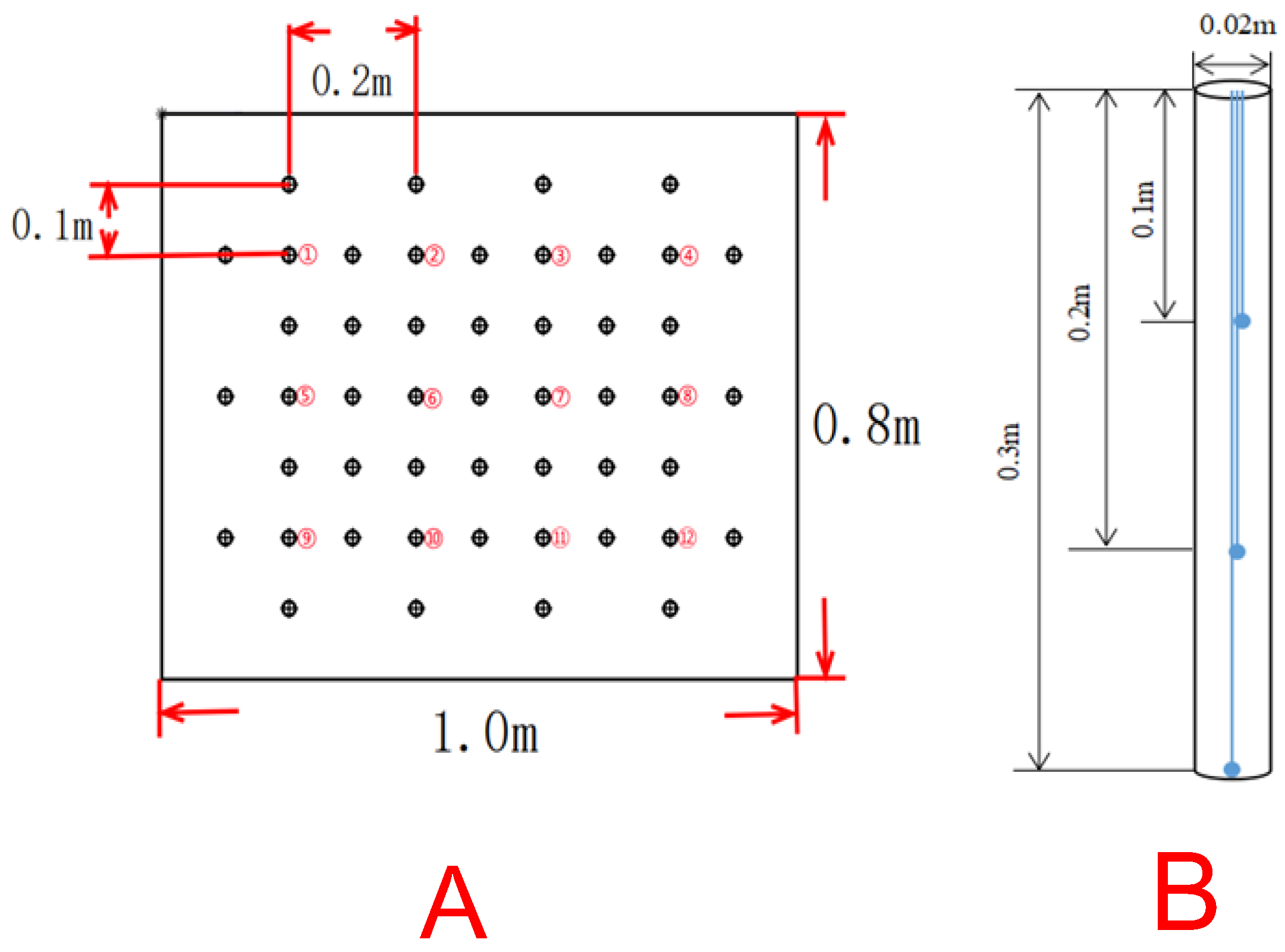
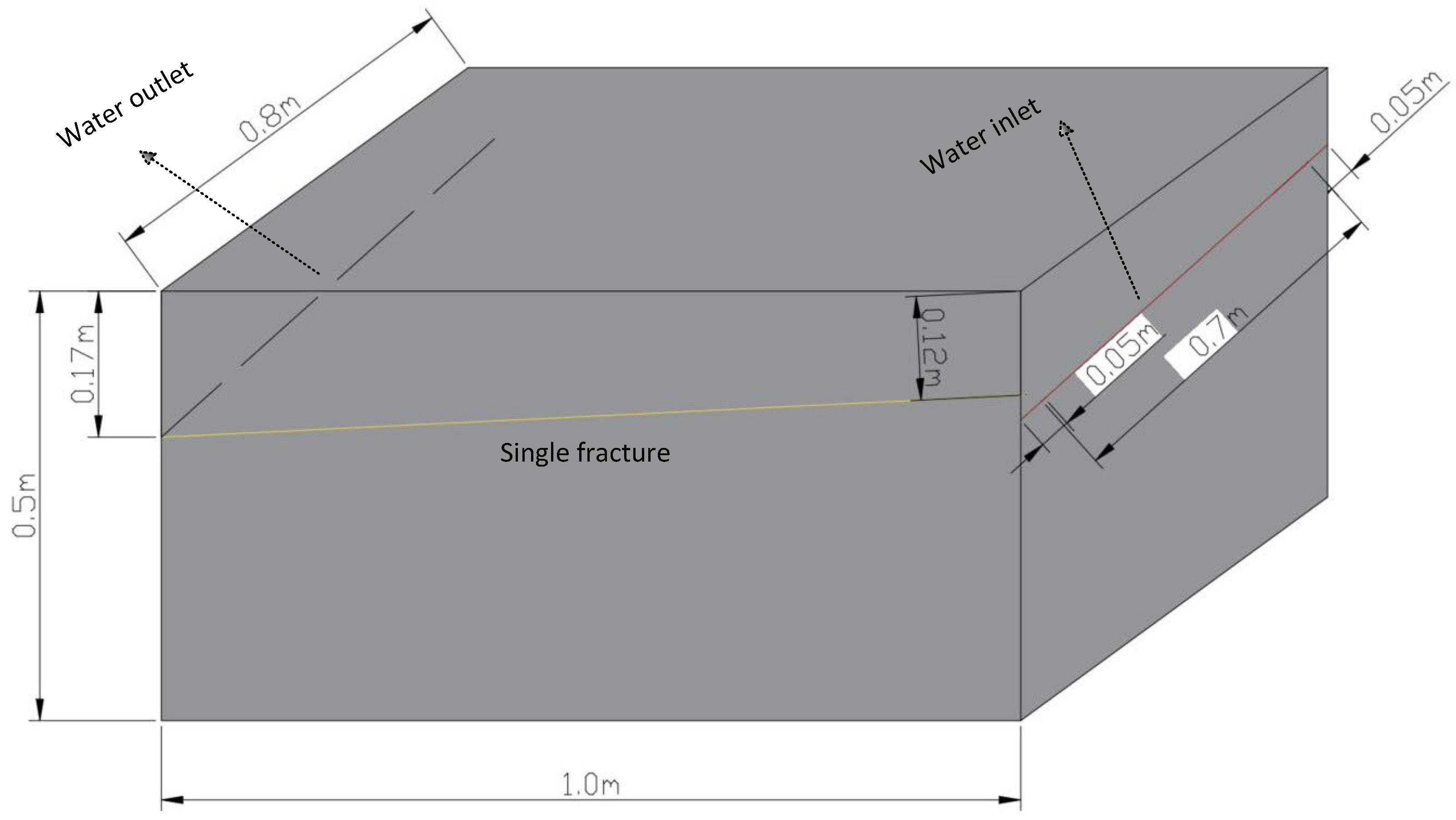
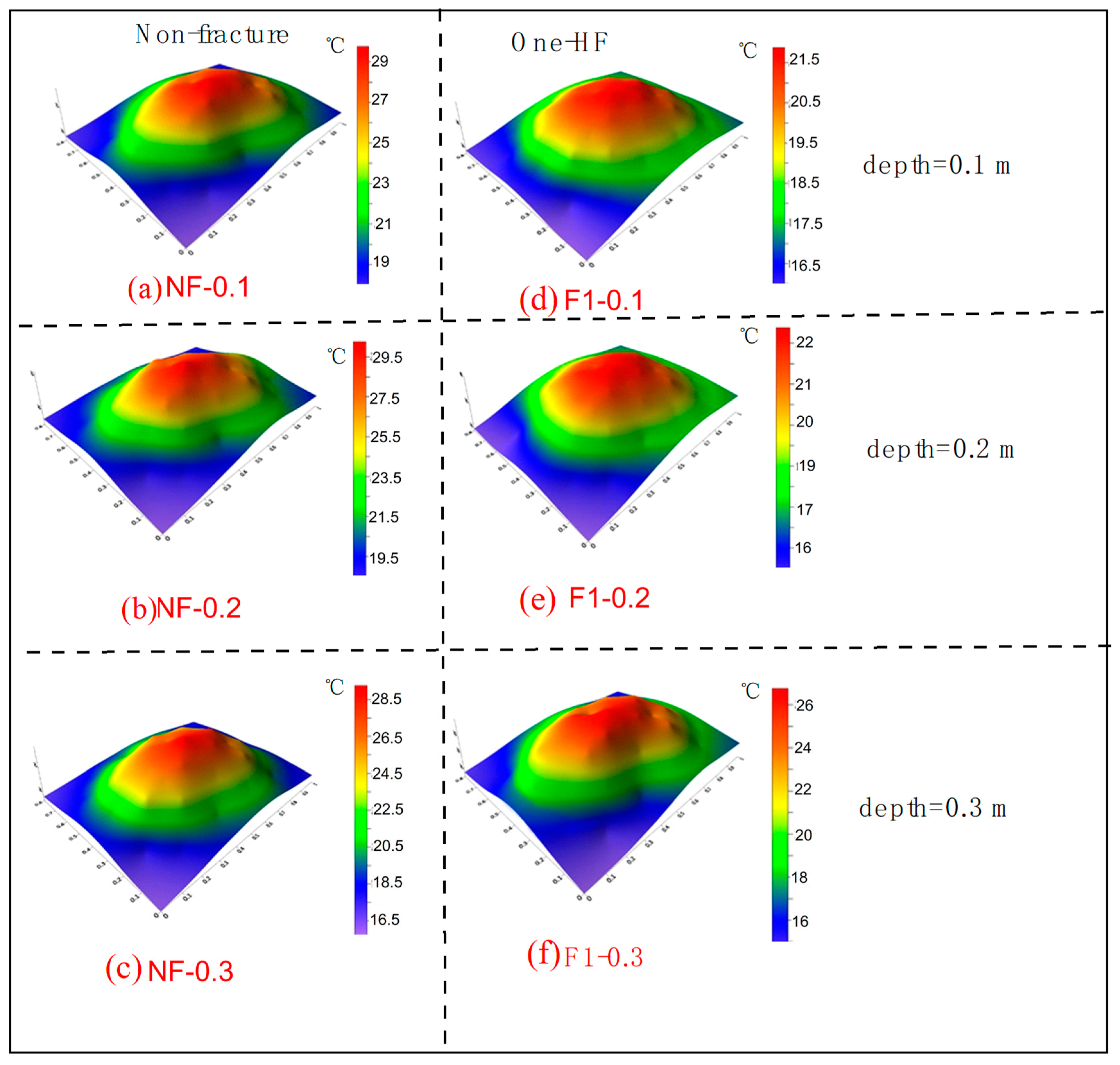

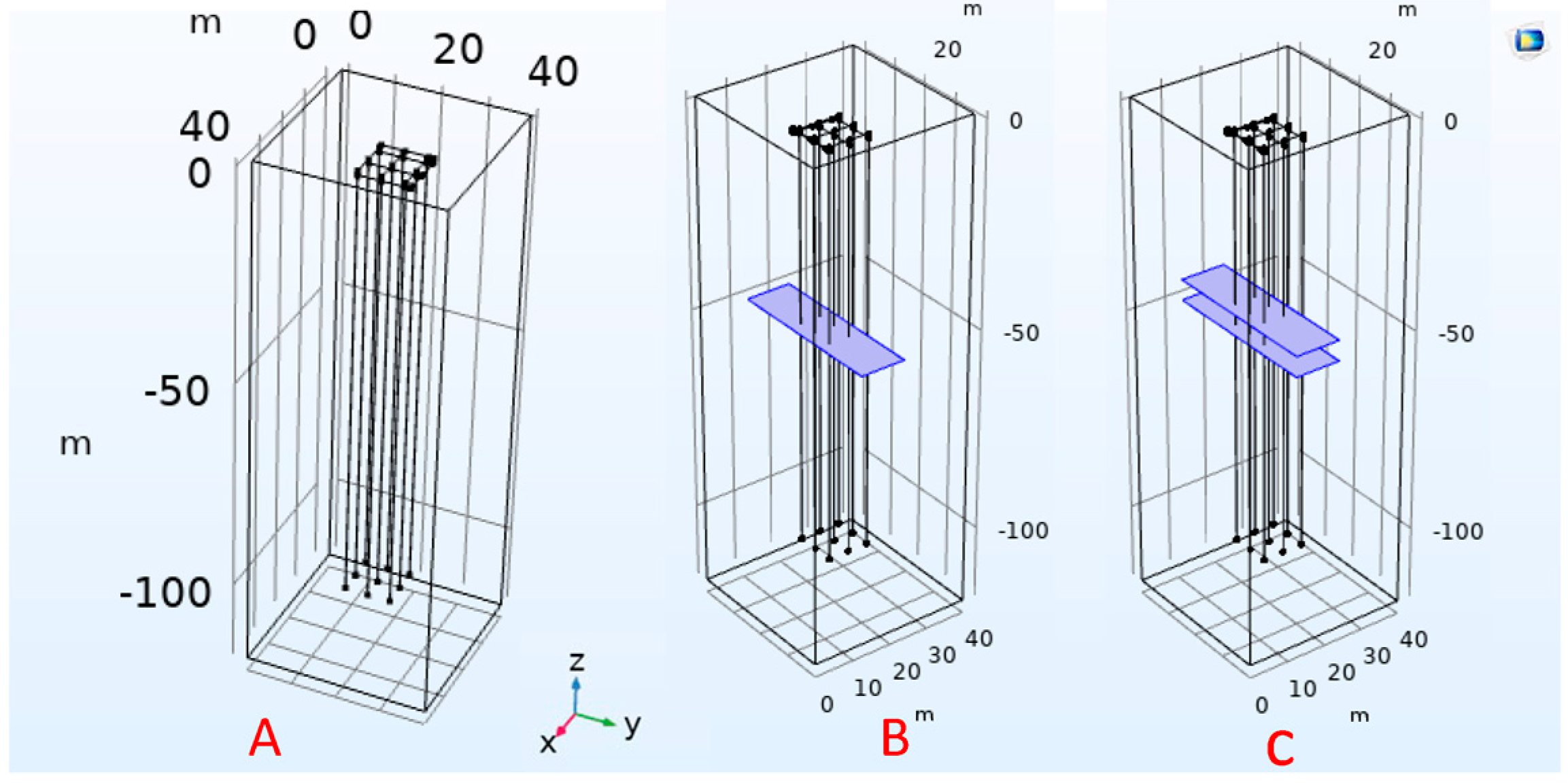
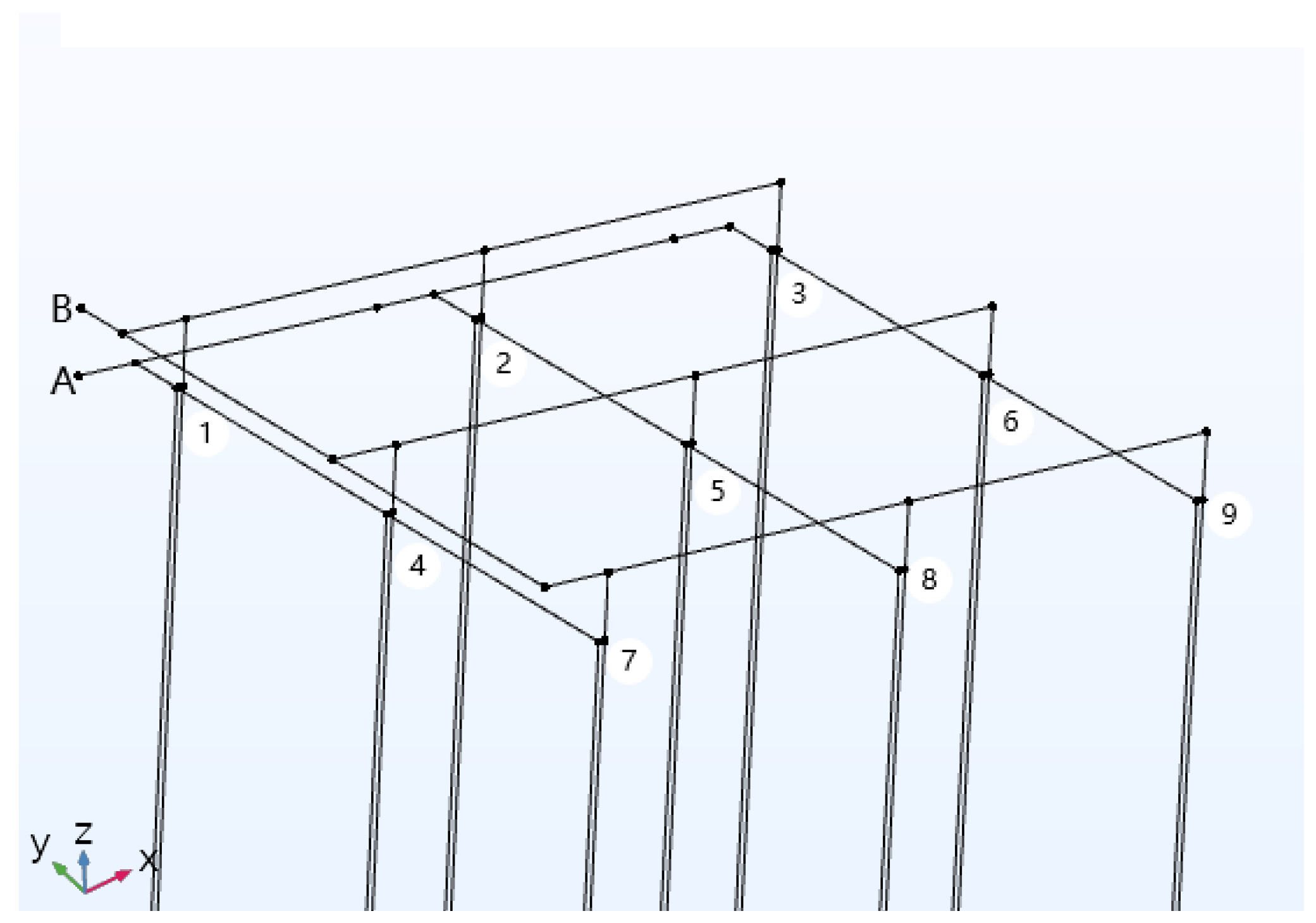
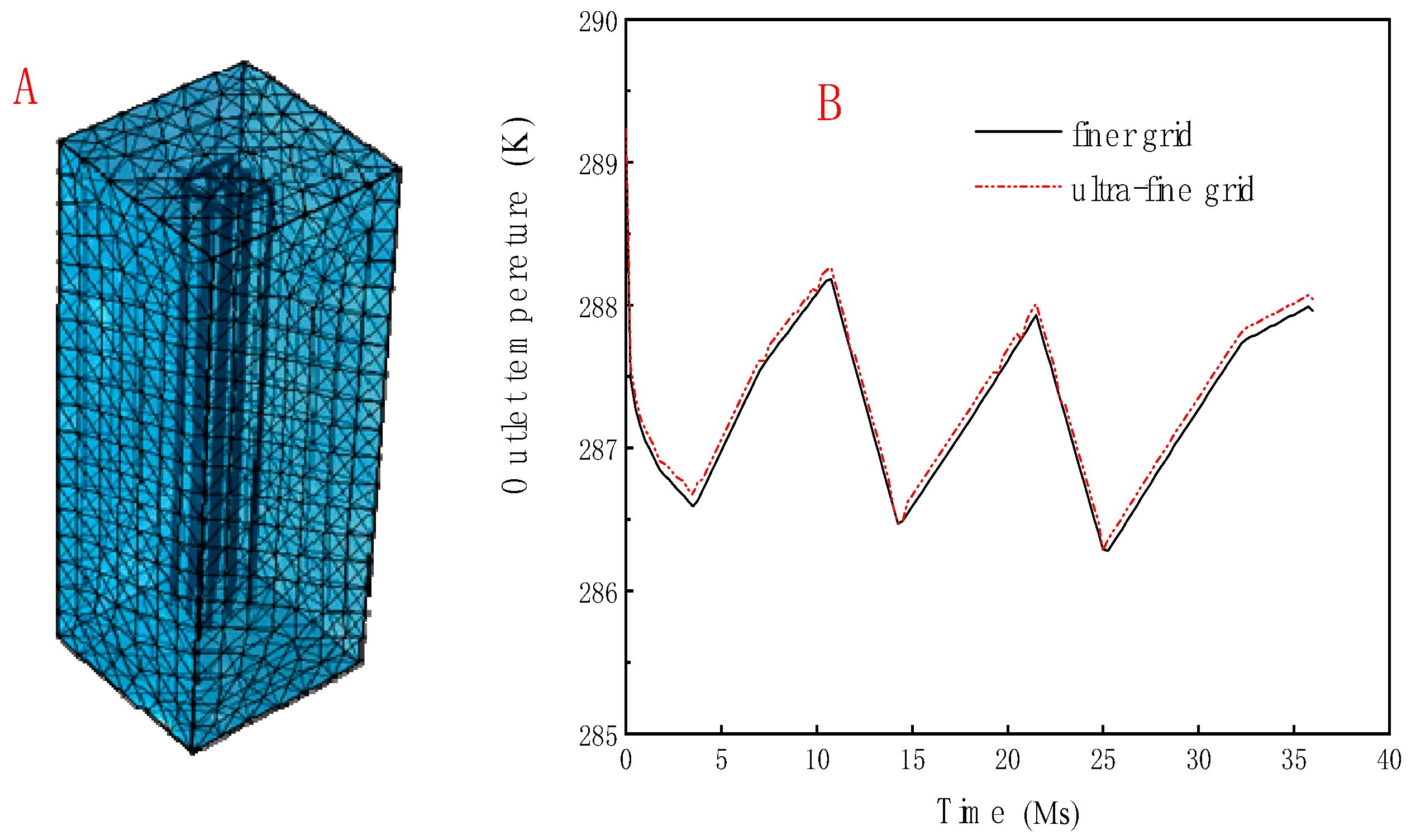
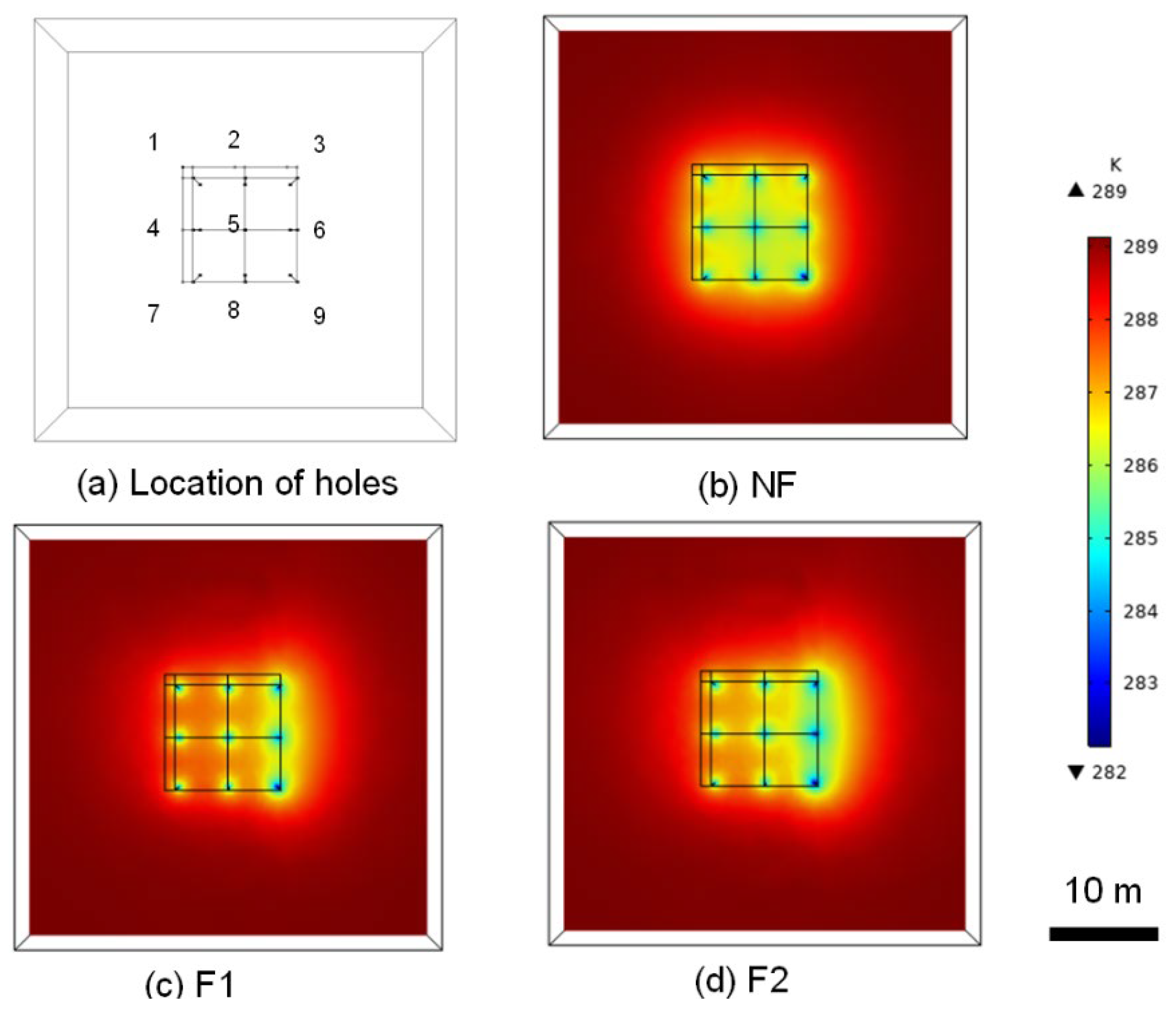

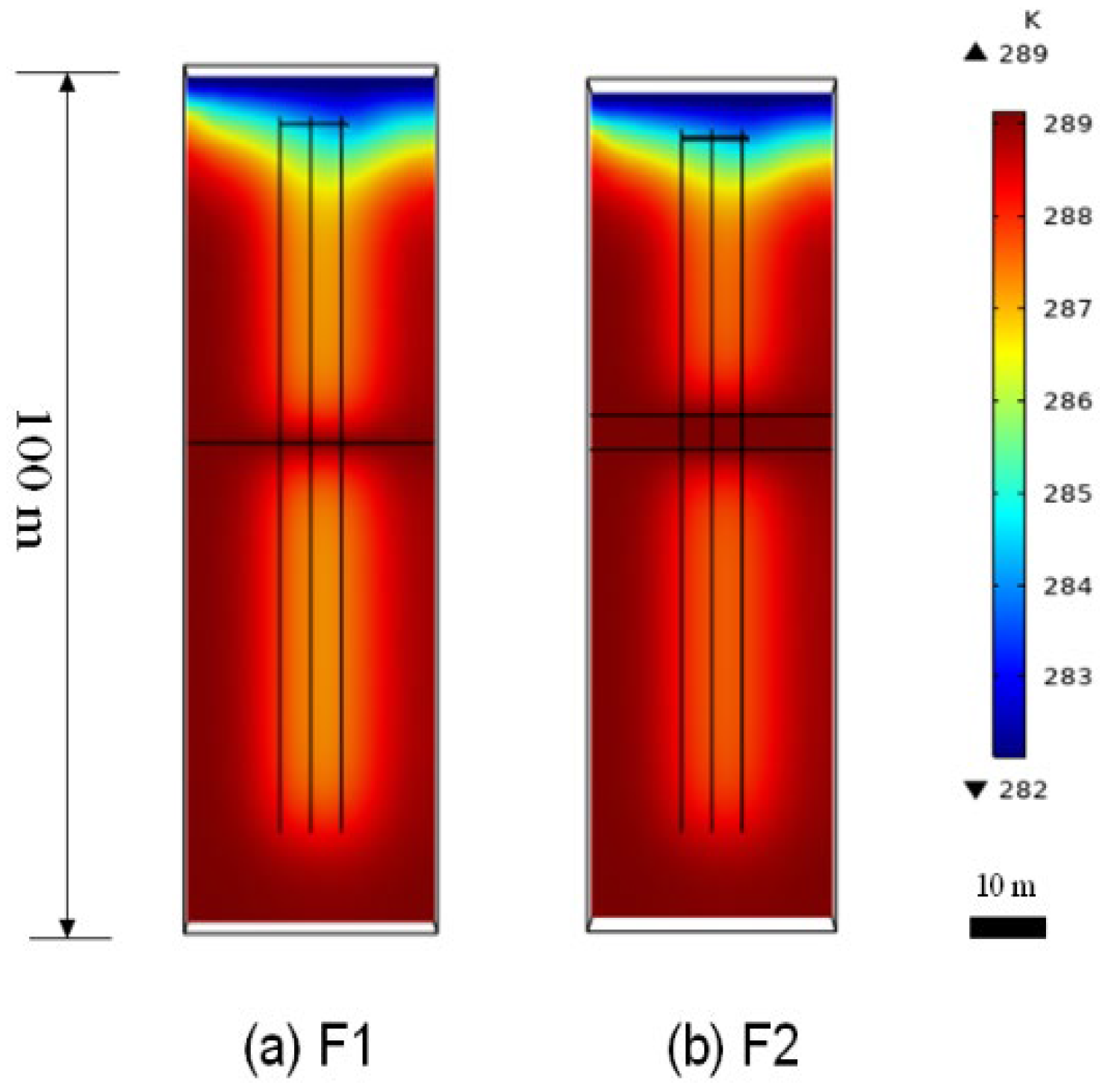

| Parameter | Description of Physical Parameters | Value | Unit |
|---|---|---|---|
| T_init_m | Initial temperature of rock mass | 289.15 [16] | K |
| C_p_eff | Specific heat capacity of rock mass | 890 [16] | J/(kg·K) |
| k_eff k_air | Thermal conductivity of rock mass Thermal conductivity of air | 2.95 [17] 0.026 [17] | W/(m·K) W/(m·K) |
| Kappa_m | Permeability of rock mass | 1 × 10−15 [16] | m2 |
| u_pipe | Velocity of fluid in U pipe | 0.70 [18] | m/s |
| Tjin_w | Input temperature of working fluid in winter | 280.15 [1] | K |
| T_init_p | Initial temperature of U pipe | 289.15 [18] | K |
| k_pipe | Thermal conductivity of U pipe | 0.43 [18] | W/(m·K) |
| ϕ | Porosity of matrix | 0.01 [16] | / |
| r_W | Density of groundwater | 1000 [17] | Kg/m3 |
| w_f | Width of fracture | 1 × 10−4 [17] | m |
| k_w | Thermal conductivity of water | 0.59 [17] | W/(m(K) |
| Cp_w | Specific heat capacity of water | 2400 [17] | J/(kg(K) |
| Cp_f | Specific heat capacity of fracture | 930 [17] | J/(kg(K) |
| T_c | Daily cooling time | 24 [18] | h |
| T_ft | Temperature of fracture water | 289.15 [16] | K |
Publisher’s Note: MDPI stays neutral with regard to jurisdictional claims in published maps and institutional affiliations. |
© 2022 by the authors. Licensee MDPI, Basel, Switzerland. This article is an open access article distributed under the terms and conditions of the Creative Commons Attribution (CC BY) license (https://creativecommons.org/licenses/by/4.0/).
Share and Cite
Luo, T.; Pei, P.; Wu, J.; Wang, C.; Tang, L. Research on the Application of Fracture Water to Mitigate the Thermal Imbalance of a Rock Mass Associated with the Operation of Ground-Coupled Heat Pumps. Energies 2022, 15, 6385. https://doi.org/10.3390/en15176385
Luo T, Pei P, Wu J, Wang C, Tang L. Research on the Application of Fracture Water to Mitigate the Thermal Imbalance of a Rock Mass Associated with the Operation of Ground-Coupled Heat Pumps. Energies. 2022; 15(17):6385. https://doi.org/10.3390/en15176385
Chicago/Turabian StyleLuo, Tingting, Peng Pei, Jianan Wu, Chen Wang, and Long Tang. 2022. "Research on the Application of Fracture Water to Mitigate the Thermal Imbalance of a Rock Mass Associated with the Operation of Ground-Coupled Heat Pumps" Energies 15, no. 17: 6385. https://doi.org/10.3390/en15176385
APA StyleLuo, T., Pei, P., Wu, J., Wang, C., & Tang, L. (2022). Research on the Application of Fracture Water to Mitigate the Thermal Imbalance of a Rock Mass Associated with the Operation of Ground-Coupled Heat Pumps. Energies, 15(17), 6385. https://doi.org/10.3390/en15176385







